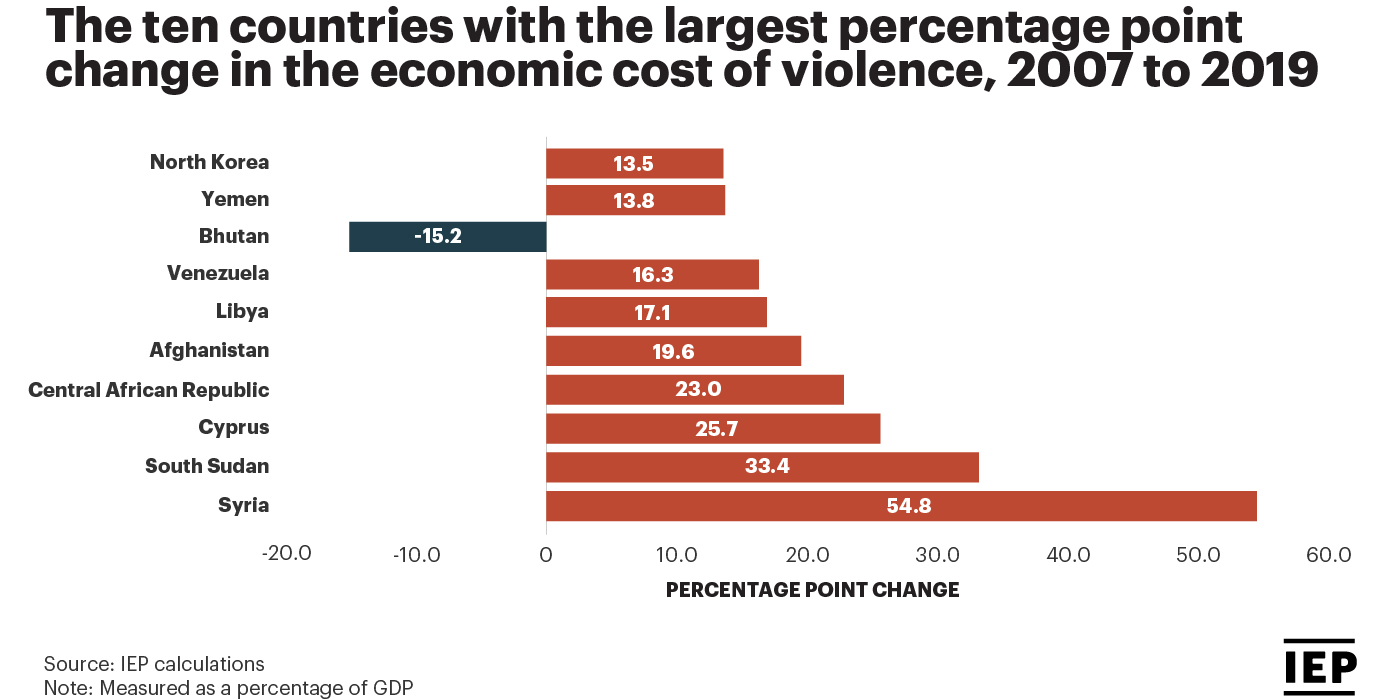
This chart shows the ten countries that have had the largest changes in their economic cost of violence from 2007 to 2019.
Since 2007, nine out of the ten countries with the largest change in their economic cost have recorded increases with the exception of Bhutan who improved. Syria recorded the largest percentage point increase.
Only one country — Bhutan — showed a significant decrease in the economic cost of violence reducing by 15 percentage points from 23% of gross domestic product in 2007, to 8% in 2019, primarily driven by a reduction in the cost of Armed Conflict domain.
One of the major challenges in developing policies aimed at increasing peace is the difficulty of being able to accurately gauge the benefits that result from peace.
Recognising this, the Institute for Economics and Peace (IEP) has developed a new and ground breaking methodology to estimate the cost of violence to the global economy, including calculations for 152 countries that detail the costs of thirteen different types of violence.
This deeper insight into the breakdown of national costs of violence allows for better targeting of development assistance and also enables national governments to more accurately assess the costs associated with violence and the likely benefits that would flow from improvements in peace.
In developing this methodology IEP uses the concept of ‘violence containment’ spending.
IEP defines violence containment spending as economic activity that is related to the consequences or prevention of violence where the violence is directed against people or property.
This approach uses ten indicators from the Global Peace Index (GPI) and three additional key areas of expenditure to place an economic value on 13 different dimensions.
This process has been developed to enable relative comparisons between countries at different levels of economic development. GDP per capita has been used to scale the cost of violence containment for each country.
In both the U.S. and the U.K. a number of robust analyses have been conducted on the cost of various types of violence and have been used as the basis for the scaling.
The economic impact of violence containment to the world economy in 2012 was estimated to be $9.46 trillion or 11% of Gross World Product (GWP).*
This figure is comprised of $4.73 trillion of direct and indirect costs as well as an additional $4.73 trillion in additional economic activity that would flow from the reinvestment of these costs into more fruitful economic activities.
Were the world to reduce its expenditure on violence by 15% it would be enough to provide the necessary money for the European Stability Fund, repay Greece’s debt and cover the increase in funding required to achieve the United Nation’s Millennium Development Goals.
One of the easier items to count is military expenditure, thus it is nearly fully included in the study.
Military spending constitutes 51% of the total accounted expenditure on violence containment. However, the approach excludes many other forms of violence containment due to a lack of available data.
If other forms of violence were included in the overall estimate, it is expected that military spending would drop considerably as a proportion of total violence containment expenditure.
It is important to highlight that the world’s direct expenditure on the military is more than 12 times the world’s expenditure on foreign aid, as measured by Official Development Assistance (ODA).
The economic impact of homicides represents the next most significant cost at $1.43 trillion dollars or 15% of the total impact.
The third largest contributor is spending on internal security officers and police, accounting for around 14% of the total, or $1.3 trillion dollars of the economic impact.